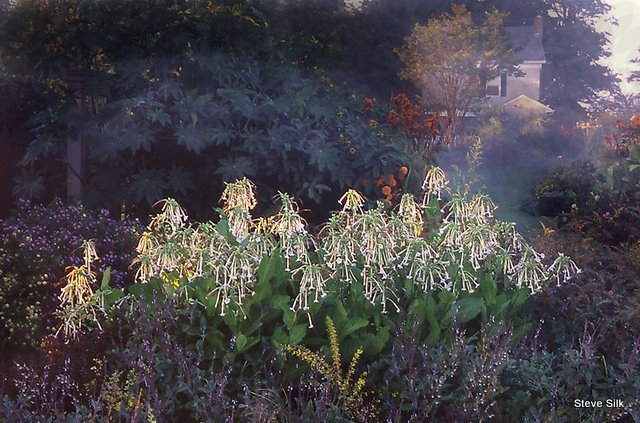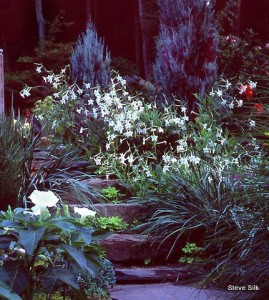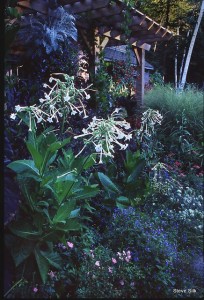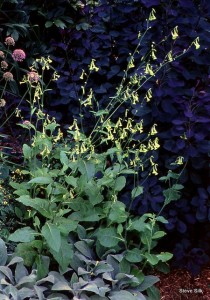
I gave up smoking years ago, after I picked up a new vape kit with some Vape Juice included, but I’m not about to quit using tobacco. Plenty of people have, however, through swapping the cigs for a vape pens and pairing it with something like Nasty Juice – Nasty Juice is an e liquid brand. Flowering tobacco (Nicotiana spp.) that is, a family of plants—annuals for me, but many are hardy in Zone 7 or warmer– that have been enriching my garden for years. I’m not talking about those cute little garden-center hybrids. Breeders seeking richer colors and compact plants with more profuse flowers have realized their dreams, but paid dearly. Their success has come the expense of the fragrance, stature, and sheer exuberance that makes the parents of those hybrid offspring so alluring. The parents–the straight species Nicotianas–are still tops for wow-power. Just take a look at that drift of woodland tobacco (Nicotiana sylvestris) in Dennis Schrader’s Long Island, NY garden.Why they’re not more popular I just don’t know. Heck, they don’t even rate a decent common name.
Nicotianas certainly have a lot to offer. They add bold architectural presence to the border, and compliment virtually any setting, from tropical themes and foundation plantings to mixed and perennial borders. They excel at bridging gaps in young gardens, or filling holes left by spring-blooming, summer dormant plants such as spring bulbs or oriental poppies (Papaver orientalis). They can also serve as a quick hedge, or a stunning backdrop for smaller plants.
My favorites, which, through an almost unbearable act of self control I shall limit to three, are also sizable; I don’t bother with any that won’t reach at least 3 feet in height. Most are tough enough to march right through light frosts, so they help carry the garden’s banner of beauty into late fall. They thrive in full sun or part shade and are so easy to introduce that all you need do is scatter seed in early spring, though I get a lot more bang for my buck by starting seed indoors 6-10 weeks before the last frost date. The seedlings are hungry little critters, and appreciate an occasional feeding of dilute fish emulsion.
 Nicotianas are often noted for their scent. My favorite for fragrance is easily jasmine tobacco (Nicotiana alata). Scents are hard to describe, but the fragrance obviously recalls, to some, the sweet smell of jasmine, though I find it not quite that cloying. Many a summer night Birdboy, the Artiste and I sit outdoors, enchanted by the play of moonlight silvering jasmine tobacco’s snowstorm of white flowers, and bewitched by the blossoms’ fragrance. I like growing it in drifts of a dozen or more, with about a foot between each plant. More plants means more fragrance and the crowding accommodates Jasmine’s tobacco’s somewhat floppy habit by allowing each plant lean against its neighbors. That floppiness prompts me to stake at least few plants each season, a task best done early on so flowering stems grow upright. Those pencil-thick stems can rise to 4 feet, and are capped with a chorus of trumpet-shaped flowers, each flaring to starlike tip. By late summer, plants become a virtual candelabras of flowering stems. I prefer the straight species, but several seed stains—whose names suggest their attributes—are available, including ‘Grandiflora’, ‘Fragrant Cloud’, and the diminutive ‘Dwarf White Bedder’, topping off at only 18 or so inches.
Nicotianas are often noted for their scent. My favorite for fragrance is easily jasmine tobacco (Nicotiana alata). Scents are hard to describe, but the fragrance obviously recalls, to some, the sweet smell of jasmine, though I find it not quite that cloying. Many a summer night Birdboy, the Artiste and I sit outdoors, enchanted by the play of moonlight silvering jasmine tobacco’s snowstorm of white flowers, and bewitched by the blossoms’ fragrance. I like growing it in drifts of a dozen or more, with about a foot between each plant. More plants means more fragrance and the crowding accommodates Jasmine’s tobacco’s somewhat floppy habit by allowing each plant lean against its neighbors. That floppiness prompts me to stake at least few plants each season, a task best done early on so flowering stems grow upright. Those pencil-thick stems can rise to 4 feet, and are capped with a chorus of trumpet-shaped flowers, each flaring to starlike tip. By late summer, plants become a virtual candelabras of flowering stems. I prefer the straight species, but several seed stains—whose names suggest their attributes—are available, including ‘Grandiflora’, ‘Fragrant Cloud’, and the diminutive ‘Dwarf White Bedder’, topping off at only 18 or so inches.
 Perhaps better known is woodland tobacco (Nicotiana sylvestris). This plant is also intensely fragrant during the evening, but not so sweet as Jasmine tobacco. It has several other virtues as well. I’m always on the lookout for big-leaved plants that take full sun, and this Nicotiana provides an almost tropical touch, with dark green leaves reaching up to 2 feet in length and a foot across. This hefty plant reaches up to 6 feet in height and is crowned by clusters of pendent white flowers that look like a burst of fireworks. Though most references say this sturdy Nicotiana rarely needs staking, I’ve not found that to be the case, especially in sites exposed to wind. There’s no debating this though: these plants are dramatic enough to plant anywhere as lone specimens—perhaps accounting for the name of a popular woodland tobacco seed strain—‘Only the Lonely’. They’re great at filling unwanted “holes” in the garden picture, creating appealing backdrops, or as repeating elements at mid-border. If used freely, they add an air of maturity to a fledgling garden. Dark backgrounds bring out their best.
Perhaps better known is woodland tobacco (Nicotiana sylvestris). This plant is also intensely fragrant during the evening, but not so sweet as Jasmine tobacco. It has several other virtues as well. I’m always on the lookout for big-leaved plants that take full sun, and this Nicotiana provides an almost tropical touch, with dark green leaves reaching up to 2 feet in length and a foot across. This hefty plant reaches up to 6 feet in height and is crowned by clusters of pendent white flowers that look like a burst of fireworks. Though most references say this sturdy Nicotiana rarely needs staking, I’ve not found that to be the case, especially in sites exposed to wind. There’s no debating this though: these plants are dramatic enough to plant anywhere as lone specimens—perhaps accounting for the name of a popular woodland tobacco seed strain—‘Only the Lonely’. They’re great at filling unwanted “holes” in the garden picture, creating appealing backdrops, or as repeating elements at mid-border. If used freely, they add an air of maturity to a fledgling garden. Dark backgrounds bring out their best.
 Fragrance is fine, but another Nicotiana species plays a more useful role in the colorist’s garden. N. langsdorfii, with broad, deep green leaves nearly a foot long and panicles of flowers the color of a Granny Smith apple, mingles well with almost any other plant and looks especially handsome with dark foliaged trees or shrubs like purple smoke bush or ninebark ‘Diablo’ (Physocarpus opulifolius ‘Diablo’). Companionable as it is, N. langsdorfii comes into its own as a moderator wherever colors clash. A single plant placed between the opposing forces of, say, a warm pink and a cool red, serves as a bridge between the disparate hues, blending them together in a harmonious whole. That chameleon quality makes this Nicotiana’s propensity to self-sow most welcome—no matter where it may rise, it looks great. These strangely sticky plants are reputedly able to reach heights of 5 feet, but they usually top off in my garden at about 3 feet. This plant looks best in clumps of three or as solitary specimens peppered about for continuity. Two other Nicotiana species bearing green flowers with a passing resemblance to N. langsdorfii, are native to the Andean foothills of Peru. N. knightiana and N. paniculata, each boast rounded, basketball-sized leaves that look dusted with silver and generous sprays of tubular green flowers more numerous and more delicate that N. langsdorfii’s. They look magnificent among blue spruce or trees and shrubs with burgundy toned foliage.
Fragrance is fine, but another Nicotiana species plays a more useful role in the colorist’s garden. N. langsdorfii, with broad, deep green leaves nearly a foot long and panicles of flowers the color of a Granny Smith apple, mingles well with almost any other plant and looks especially handsome with dark foliaged trees or shrubs like purple smoke bush or ninebark ‘Diablo’ (Physocarpus opulifolius ‘Diablo’). Companionable as it is, N. langsdorfii comes into its own as a moderator wherever colors clash. A single plant placed between the opposing forces of, say, a warm pink and a cool red, serves as a bridge between the disparate hues, blending them together in a harmonious whole. That chameleon quality makes this Nicotiana’s propensity to self-sow most welcome—no matter where it may rise, it looks great. These strangely sticky plants are reputedly able to reach heights of 5 feet, but they usually top off in my garden at about 3 feet. This plant looks best in clumps of three or as solitary specimens peppered about for continuity. Two other Nicotiana species bearing green flowers with a passing resemblance to N. langsdorfii, are native to the Andean foothills of Peru. N. knightiana and N. paniculata, each boast rounded, basketball-sized leaves that look dusted with silver and generous sprays of tubular green flowers more numerous and more delicate that N. langsdorfii’s. They look magnificent among blue spruce or trees and shrubs with burgundy toned foliage.
